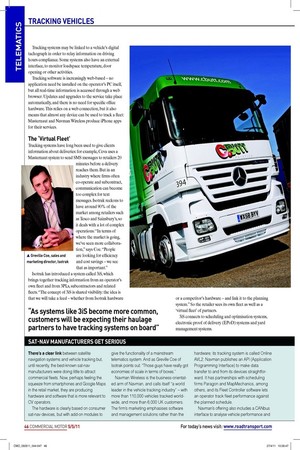The days of tracking systems just ‘putting a dot on
Page 39

Page 41

Page 42

If you've noticed an error in this article please click here to report it so we can fix it.
a map’ are gone. With the right interfaces and software, you can monitor Loads, provide reports on fleet performance, monitor driver safety, improve customer service and more
Words: Toby Clark Vehicle tracking has been the mainstay of large leets for some time, and is a pretty common itment in even small leets now. As the telematics market has matured, the software has evolved to offer so much more than just tracking an individual vehicle.
“Telematics is now a commodity,” says Andy Kirk, sales and marketing director of tracking irm Quartix. “The telematics system is so cost-effective that it shouldn’t cost you very much.” As a result, the emphasis has changed: whereas tracking providers used to stress the features of their hardware – size, ruggedness, ease of itment, and so on – now their marketing is all about what their products offer in terms of reporting, benchmarking and integration with other systems. Tracking systems are expected to talk to routeing and scheduling software, tachograph monitoring services, electronic resource planning (ERP) systems and much more.
The emphasis has also changed from theft prevention and reporting the driver’s activities to optimising leet performance and strategic planning: whereas every tracking irm used to wheel out examples of drivers caught spending hours off their routes, now they justify their products in terms of carbon footprint and ROI (return on investment). Some don’t even deine themselves as tracking providers any more. Greville Coe, sales and marketing director of Isotrak, says: “We see ourselves more as a systems integrator in the telematics space.” So what exactly can tracking systems do, and how can you choose between them?
Hardware & software
Each vehicle to be tracked is itted with a small powered tracking device, which typically contains a GPS receiver and a communications device operating on the GSM or 3G mobile phone network. This device is given various names – for example, Masternaut calls it an MCU, while Microlise calls its product the ‘MTU3 in-vehicle computer’.
The capabilities of these devices have changed: where they used to be single-function devices, now many can be connected to a vehicle’s CANbus data network, transmitting information on vehicle condition, fuel usage and driver behaviour. These connections used to be proprietary, and there was no guarantee that a particular vehicle would talk to a third-party tracking system, but as Kirk puts it: “Anything installed as part of a vehicle is so standardised and so well documented that it is a bread-and-butter process.” Tracking systems may be linked to a vehicle’s digital tachograph in order to relay information on driving hours compliance. Some systems also have an external interface, to monitor loadspace temperature, door opening or other activities.
Tracking software is increasingly web-based – no application need be installed on the operator’s PC itself, but all real-time information is accessed through a web browser. Updates and upgrades to the service take place automatically, and there is no need for speciic ofice hardware. This relies on a web connection, but it also means that almost any device can be used to track a leet: Masternaut and Navman Wireless produce iPhone apps for their services.
The ‘Virtual Fleet’
Tracking systems have long been used to give clients information about deliveries: for example, Ceva uses a Masternaut system to send SMS messages to retailers 20 minutes before a delivery reaches them. But in an industry where irms often co-operate and subcontract, communication can become too complex for text messages. Isotrak reckons to have around 90% of the market among retailers such as Tesco and Sainsbury’s, so it deals with a lot of complex operations: “In terms of where the market is going, we’ve seen more collaboration,” says Coe. “People
▲ Greville Coe, sales and are looking for eficiency marketing director, Isotrak and cost savings – we see
that as important.” Isotrak has introduced a system called 3iS, which brings together tracking information from an operator’s own leet and from 3PLs, subcontractors and related leets. “The concept of 3iS is shared visibility: the idea is that we will take a feed – whether from Isotrak hardware or a competitor’s hardware – and link it to the planning system.” So the retailer sees its own leet as well as a electronic proof of delivery (EPoD) systems and yard ‘virtual leet’ of partners. 3iS connects to scheduling and optimisation systems,
partners to have tracking systems on board” management systems. This can prevent clashes (for instance when vehicles from different leets might arrive at the same depot at the same time) and allows the retailer to look at the KPIs of all its partners.
There is no formal list of 3iS-compliant tracking systems yet, but Coe suggests that most mainstream systems will be compatible.
The implication is clear: as systems like 3iS become more common, customers will be expecting their haulage partners to have tracking systems on board.
And likewise, you will ind that customers expect you to provide live data on your leet’s activities and performance. The future will be increasingly transparent. ■
















































